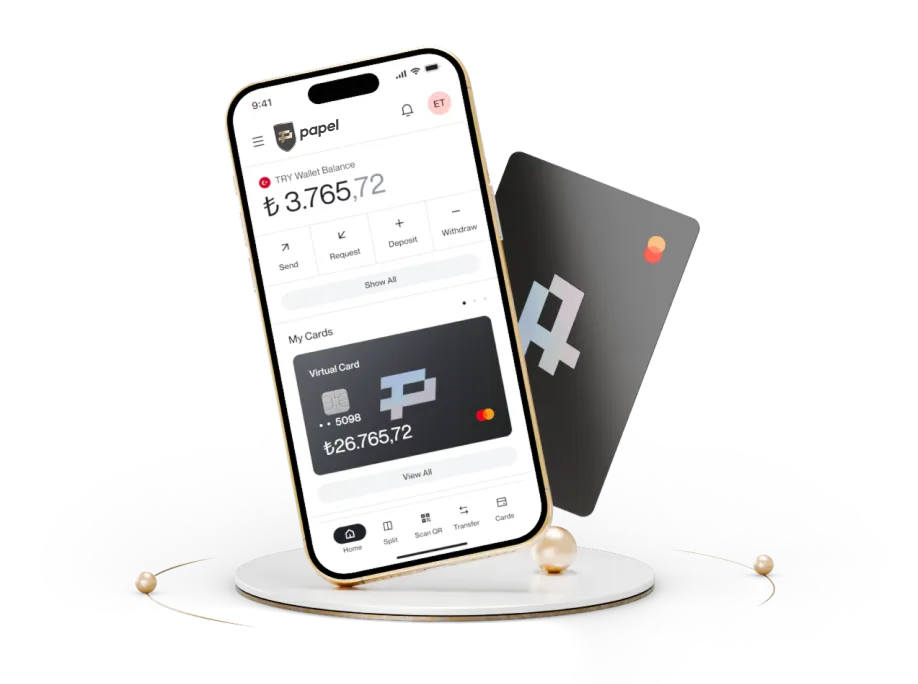Nakit Kullanımının Azaldığı 5 Ülke: Dijital Ödeme Çağı
Geleneksel nakit kullanımı yerini dijital ödeme sistemlerine bırakırken, kartlı ödemeler, mobil cüzdanlar ve temassız işlemler günlük hayatın vazgeçilmez bir parçası haline geliyor. Teknolojik gelişmeler ve devletlerin nakitsiz ekonomiyi teşvik eden politikalarıyla birlikte, fiziksel paraya duyulan ihtiyaç her geçen gün azalıyor. Peki, bu dönüşüm nasıl başladı ve neden hızla yayılıyor? İşte nakit kullanımının giderek azalmasının arkasındaki temel nedenler…
Nakit kullanımı neden azalıyor?
Dijital dönüşümün finansal işlemlere de yansımasıyla beraber nakit kullanımı her geçen gün azalıyor. Dijital ödeme sistemlerinin sundukları avantajlar sebebiyle toplumların finansal alışkanlıkları dönüşüm geçirerek nakit kullanımında azalmaya neden oluyor. Nakit para kullanımının azalmasına sebep olabilecek iki temel faktör var. Bu faktörleri şu şekilde sıralayabiliriz:
Dijital ödeme sistemlerinin yükselişi
Kartlı ödeme sistemi 1950’lerden beri var olan ve yaygın olarak kullanılan sistem. Fakat 90’lı yılların ardından internetin de yaygınlaşmasıyla elektronik ticaret kavramı konuşulmaya başlandı ve PayPal’ın da kurulmasıyla beraber online ödeme sistemi dönüm noktası yaşadı. Bu dönüm noktasını 2010’larda akıllı telefonların yaygınlaşması takip etti ve böylece mobil ödeme sistemleri kullanılmaya başlandı.
Günümüzde ise geleneksel nakit kullanımı yerini dijital ödeme yöntemlerine bırakıyor. Dijital cüzdanlar, mobil ödeme sistemleri, temassız ödeme teknolojileri gibi kullanıcılara daha hızlı ve pratik bir şekilde ödeme yapma seçeneği sunan yenilikçi çözümler özellikle pandemi sonrasında daha da yaygınlaştı ve artık nakit para neredeyse ihtiyaç duyulmaz bir araç oldu. Ayrıca kripto para gibi dijital ortamda üretilen paralar da oldukça popüler ve dünya çapında dikkat çekti. Ülkeler kriptolarla ilgili politikalar ve kararlar almaya başladı bile. Dijital cüzdan ve elektronik para kavramları sana uzaksa sana yardımcı olmak isteriz, Dijital Cüzdan ve Elektronik Para Nedir, Nasıl Kullanılır? Yazımızda merak ettiğin sorulara cevap bulabilirsin.
Hükümetlerin nakit kullanımını azaltma politikaları
Birçok ülke, kayıt dışı ekonomiyi azaltmak, vergi gelirlerini artırmak ve finansal sistemin şeffaflığını sağlamak için nakit kullanımını sınırlayan politikalar uygulamakta. Buna örnek olarak İstanbul Büyükşehir Belediyesi’ne bağlı BELTUR şubelerinin 1 Ocak 2025’ten itibaren sadece kartla ödeme kabul etmeye başlamasını gösterebiliriz. Bu örnek de dijital ödeme sistemlerine geçiş açısından önemli bir adım diyebiliriz.
Nakit kullanımının en az olduğu 5 ülke
Dijital ödeme sistemlerinin benimsenmesi ve gelişmiş teknolojik altyapılarıyla dikkat çeken ve nakit kullanımı en az olan 5 ülke şu şekildedir.
İsveç: Dünyanın ilk nakit bırakan ülkesi
Nakitsiz yaşamı en fazla benimseyen ülkelerin başında İsveç gelmekte. Nakit işlemlerin oranı ülke nüfusunun yalnızca %3’üne kadar düşmüş olan İsveç’te en basit ödemeler bile Swish gibi mobil uygulamalar aracılığıyla gerçekleştirilmekte. Bununla beraber İsveç 2025 yılı içinde banknot kullanımına da son vermeyi planlamakta.
Norveç ve dijital bankacılıkta liderlik
Dijital ödeme sistemlerinin yaygınlığıyla dikkat çeken bir diğer ülke de Norveç’tir. 2030 yılına kadar tamamen nakitsiz bir topluma geçmeyi hedefleyen Norveç, bu geçişle işletmelerin maliyetlerini düşürmek, güvenliği artırmak ve kara para aklama faaliyetlerini zorlaştırmayı amaçlamakta.
Güney Kore ve mobil ödeme sistemleri
Mobil ödeme sistemlerinin yoğun olarak kullanıldığı ve nakit kullanımını azaltan ülkelerden biri de Güney Kore’dir. Dijital ödemeler, sahip oldukları gelişmiş altyapı sayesinde Güney Kore için günlük yaşama adapte olmuştur. Gelişmiş altyapıya sahip oldukları için ülke nakitsiz topluma hızla geçiş yapabilir.

Çin’de QR Kod ödeme çılgınlığı
Ödeme sistemlerinin en yoğun kullanıldığı ülkelerden biri olan Çin’de AliPay ve WeChat Pay gibi platformların 1 milyarın üzerinde aktif kullanıcısı vardır. QR kodla ödeme yöntemi sokak satıcılarından lüks mağazalara kadar her yerde kullanılmakta ve nakit ihtiyacını ciddi derecede azaltmaktadır.
İngiltere ve temassız ödemelerin yaygınlaşması
İngiltere de temassız ödeme teknolojilerini hızla benimseyen ülkelerden biridir. 2022 yılında ülkede 23 milyondan fazla insan neredeyse hiç nakit para kullanmamıştır. Bu durumdan da anlaşıldığı üzere ülke nakitsiz topluma doğru önemli bir adım atmıştır.
Nakit kullanımının azalmasının avantajları
Nakit kullanımının azalması, dijital ödeme sistemlerinin yaygınlaşması ve teknolojik gelişmelerle birlikte giderek artan bir eğilimdir. Bu durumun elbette birçok avantajı vardır.
Kayıt dışı ekonominin azalması
Ödeme işlemlerinin tümünün dijital platformlarda kayıtlı olması vergi kaçakçılığı ve yasa dışı faaliyetlerin takip edilmesini kolaylaştırarak kayıt dışı ekonomik döngüyü azaltır. Kayıt dışı para alışverişinin azalması da beraberinde güvenli alışveriş yapabilme kolaylığını getirir.
Güvenliğin artması
Nakit taşımanın paranı çaldırma gibi riskleri vardır. Nakit taşımadığın durumda hırsızlık riski de azalır. Herhangi bir hırsızlık durumunda paranı kartlarının çalındığını bildirerek koruman mümkün.
Maliyetlerin düşmesi
Nakit parayı basmak, saklamak ve taşımak maliyetli bir durumdur. Nakit parayı azaltarak dijital ödemeleri artırmak maliyeti de düşüreceğinden ekonomik verimi de artırır.
Finansal yönetimin kolaylaşması
Dijital ödemeleri takip etmek kolaydır. Dijital ortamda yapılan ve kolayca izlenebilen harcamalar hem bireylerin hem de işletme sahiplerinin finansal yönetimini kolaylaştırır.
Nakit kullanımının azalmasının dezavantajları
Her şeyin hem avantajı hem de dezavantajı elbet vardır. Birçok yönden kullanıcıya avantaj sunan dijital ödeme yöntemlerinin de elbet bazı dezavantajları var.
Dijital erişim sorunları
Dijital ödeme sistemleri elbette pratik ama kullanmasını bilene. Bu ödeme sistemine erişimi olmayan ya da teknolojiyi kullanmakta zorlanan kişiler sistemden dışlanabilirler. Ya da tam ödeme yapacakken şarjının bitmesi, internetin çekmediği bir yerde ödeme yapmanın gerekmesi gibi erişim sorunlarıyla da karşılaşılması mümkün.
Gizlilik endişeleri
Finansal mahremiyet arıyorsan dijital ödeme sistemleri bu konuda hiç yardımcı olmayacaktır. Dijital ortamda gerçekleştirdiğin bütün işlemlerin izlenebilir olması özel harcamalarını gizlemek istiyorsan bir dezavantaj olarak görülebilir.
Siber güvenlik riskleri
Dijital cüzdanlar birçok farklı güvenlik önlemiyle korunur. Bu alanda hem ulusal hem de uluslararası birçok farklı güvenlik protokolü geliştirilmiştir. PCI DSS gibi protokoller sayesinde dijital ödemeler oldukça güvenli olsalar da, her zaman bir risk bulunur.
Harcamaların artması
Dijital ödeme yapmak kolaydır. Bu kolaylık da kişileri farkında olmadan fazla harcama yapmaya ve borçlanmaya itebilir.
Gelecekte nakit kullanımını bırakan ülkeler olacak mı?
Gelecekte bazı ülkelerin nakit parayı bırakmayı hedefledikleri bir gerçek. Özellikle İsveç bu anlamda öncü bir rol oynamakta. Benzer bir şekilde Danimarka, Avusturalya, Norveç, Çin gibi daha birçok ülke de nakit kullanımını azaltmaya yönelerek uzun vadede nakit kullanımına son vermeyi hedeflemekte. Biz ne olacağını bilemeyiz elbette fakat dijital ödeme sistemlerine geçmek istersen hemen Papel’e üye olabilir ve dijital cüzdan sahibi olarak harcama yapmaya başlayabilirsin.
Kaynaklar: 1.

